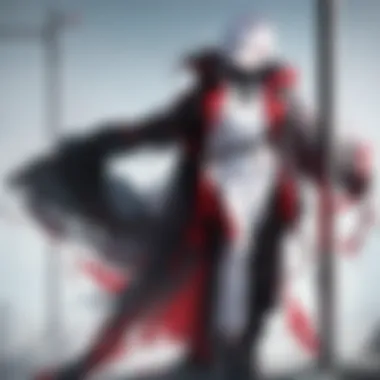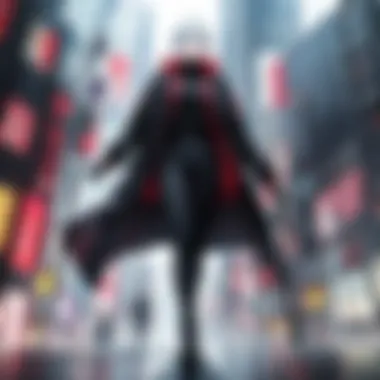Exploring Tokyo Ghoul Season One: Themes & Characters


Intro
Tokyo Ghoul, a blend of horror, action, and psychological depth, has captivated many since its release. The first season sets the stage for a complex world filled with ghouls and humans, posing the question of what it means to be human. Through its compelling narrative and character arcs, the series invites viewers to reflect on their own emotions, morality, and society. As we explore this world, understanding the intricacies of the characters and the themes they grapple with can help fans appreciate the profound impact of this story.
Character Profiles
Overview of Main Characters
The narrative is primarily driven by Ken Kaneki. Once a typical college student, his transformation into a half-ghoul marks the beginning of a profound internal conflict. Kaneki's journey is one of self-discovery, as he grapples with his new identity. His emotional turmoil and moral dilemmas create a relatable yet tragic figure that resonates with many viewers.
Another pivotal character is Touka Kirishima. Initially portrayed as aggressive and solitary, her character also develops significantly throughout the season. Touka embodies the struggle of living in a world that shuns her existence. This complexity adds depth to her interactions with Kaneki, as they both seek acceptance.
Supporting Characters
The supporting cast enriches the narrative, introducing various perspectives on ghouls and humans. Characters like Shuu Tsukiyama, with his eccentric behavior, provide an alternative view of ghoul culture. His obsession with Kaneki further complicates the already tangled relationships.
Then there is Renji Yomo, who presents a more mature insight into the ghoul world. His presence highlights existential themes and offers Kaneki guidance during tumultuous times. The various characters create a tapestry of experiences that underpin the main narrative.
Theme Exploration
Central Themes
Tokyo Ghoul explores several central themes that delve into the human psyche. The primary theme is identity, as highlighted through Kaneki's struggle with his dual nature. His transformation presents existential questions about acceptance and belonging.
Another significant theme is empathy. The show challenges viewers to understand the ghouls, often depicted as monstrous creatures. This perspective prompts the audience to reflect on the nature of humanity and its darker sides.
Cultural References
The series also weaves in various cultural elements, particularly from Japanese folklore. The portrayal of ghouls connects with traditional monsters in literature, enhancing the storytelling. References to societal issues, such as discrimination, resonate deeply with contemporary global issues, making the story relevant.
"Understanding the complexity of the characters is pivotal in grasping the deeper themes present in Tokyo Ghoul."
Popular Series and Recommendations
Top Anime Series of the Year
For fans looking for similar anime, several series stand out.
- Attack on Titan explores themes of humanity and survival.
- Death Note delves into morality and justice, much like Tokyo Ghoul.
- Tokyo Revengers emphasizes personal growth and the impacts of past decisions.
Hidden Gems in Manga
In addition to popular titles, many lesser-known manga can capture a similar audience.
- Parasyte, which deals with body horror and identity.
- Ajin: Demi-Human, exploring concepts of immortality and societal rejection.
- Homunculus, a psychological horror that digs into human consciousness.
This comprehensive exploration of Tokyo Ghoul's first season highlights its characters and themes. Each analysis not only enriches the viewer’s understanding but also fosters deeper appreciation within the anime community.
Foreword to Tokyo Ghoul
Understanding Tokyo Ghoul, especially its first season, serves as a vital stepping stone for both fans and newcomers to the series. It establishes the groundwork for the complex narrative and character dynamics that unfold throughout. Within this framework, viewers can appreciate the psychological depth and moral dilemmas faced by the characters. Discussing the significance of this introduction highlights the initial tone and direction set by the series.


Overview of the Series
Tokyo Ghoul first premiered as a manga, written by Sui Ishida, before making its way to the anime format in 2014. The story revolves around Ken Kaneki, a college student who unexpectedly finds himself entangled in the world of ghouls—creatures that consume human flesh to survive. This twist of fate thrusts Kaneki into a struggle between his humanity and the ghoul nature that starts to awaken within him.
The series cleverly interweaves themes of identity, morality, and the duality of human nature. Viewers must grapple with the blurred lines between right and wrong, as the narrative reveals the complexities of the characters. Tokyo Ghoul distinguishes itself through its character-driven storytelling, with each episode carefully building upon the psychological and emotional layers of its protagonists.
Cultural Context and Reception
Upon its release, Tokyo Ghoul garnered significant attention and sparkled debate within the anime community. The portrayal of ghouls and their interactions with humans raised questions about societal norms and ethical boundaries. The series reflects on existential themes that resonate deeply with many viewers. Its unique approach and narrative style pushed anime as a medium into new territories.
Critics praised its rich visual aesthetics and deep emotional engagement, while some voiced concerns about pacing and deviation from the manga. This mixed reception sparked discussions on forums like reddit.com, where fans shared their perspectives, connecting on complex points about the series. The cultural impact of Tokyo Ghoul remains palpable, influencing several subsequent titles and discussions about morality in anime.
The series challenges viewers to rethink preconceived notions about monsters, positioning itself as a commentary on the human condition.
In sum, the introduction to Tokyo Ghoul not just sets the stage for what unfolds in season one but lays bare the emotional core that drives the narrative forward.
Narrative Framework
The Narrative Framework is essential in understanding how a story unfolds, shapes its characters, and delivers its themes. In Tokyo Ghoul Season One, the structure not only supports the storytelling but also influences viewer engagement and emotional impact. It dictates how the plot progresses, revealing character motivations and societal conflicts.
A well-crafted narrative allows for layered revelations and character development. This framework encourages viewers to invest in the psychological struggles of the characters. By dissecting the Narrative Framework of Tokyo Ghoul, we can appreciate the intricate ways in which its story weaves together elements of horror, identity, and morality.
Plot Summary of Season One
Tokyo Ghoul follows Ken Kaneki, a college student who transforms into a half-ghoul after a chance encounter with Rize Kamishiro. Initially, he leads a normal life, navigating studies and friendships. However, after his transformation, Kaneki faces a new reality filled with danger and isolation. The series captures his journey as he struggles with his dual identity: part human and part ghoul.
The plot deepens as Kaneki seeks acceptance while grappling with his need for food, which is now human flesh. He is thrust into the violent world of ghouls, where survival often means losing aspects of one’s humanity. This tension between his old life and his new existence forms the crux of the narrative.
Key Story Arcs
Several pivotal story arcs drive the narrative forward in Tokyo Ghoul Season One:
- Kaneki’s Transformation: This arc showcases Kaneki's initial shock and adaptation to his ghoul identity. It serves as the foundation for conflicts he will face.
- The Anteiku Arc: Kaneki begins to integrate into the ghoul community. This arc presents the contrasting perspectives of ghouls and humans, exploring themes of alienation.
- The Fight Against the CCG: The introduction of the Commission of Counter Ghoul, a government organization tasked with exterminating ghouls, adds layers to the conflict. The stakes rise as Kaneki and his allies confront external threats.
- The Search for Identity: Throughout the season, Kaneki grapples with his identity. His struggles reflect a universal search for belonging and self-acceptance, resonating strongly with viewers.
Understanding these story arcs provides viewers with insights into character motivation and thematic depth. Each arc not only progresses the plot but also enriches the viewer’s understanding of the complex world of Tokyo Ghoul.
Character Analysis
The character analysis in this article plays a crucial role in dissecting the core of Tokyo Ghoul Season One. Each character provides insight into the overarching themes of the series. Understanding characters not only enriches the narrative but also engages the audience in deeper discussions about morality, identity, and transformation. The exploration of these characters reveals the psychological struggles they face, which mirrors the societal issues and philosophical questions embedded in the storyline. By focusing on character development, we can better appreciate how each individual contributes to the emotional weight and thematic depth of the series.
Ken Kaneki: The Reluctant Hero
Ken Kaneki's journey from a timid college student to a hybrid ghoul represents a significant transformation. Initially, Kaneki is characterized by his innocence and naivety. His first encounter with the world of ghouls sets into motion a tragic chain of events. As he grapples with his new identity, he becomes more introspective. Kaneki's reluctance to fully embrace his ghoul side emphasizes the duality of his existence. His internal conflict becomes a central motif in the story. This struggles resonates with viewers, as he embodies the idea of trying to balance one’s humane instincts with darker impulses.
Kaneki's character resonates with those viewing the series. His experiences encapsulate fundamental questions of self-identification and social belonging.
Rize Kamishiro: The Catalyst
Rize Kamishiro plays a pivotal role in shaping Kaneki's fate. As the catalyst of his transformation, Rize represents the unforgiving nature of the ghoul world. Initially appearing as a charming and alluring figure, her predatory instincts reveal the dangers that lurk beneath the surface. Rize's influence on Kaneki underscores themes of manipulation and inevitability. Her allure masks a ruthless survival instinct that drives her actions.
Rize's character serves as a stark contrast to Kaneki's initial worldview. She is a manifestation of the darker side of human nature—the part that can consume and destroy.
Touka Kirishima: Complexity of Identity


Touka Kirishima embodies the complications of identity within the setting of Tokyo Ghoul. As a ghoul, she struggles with her nature while trying to maintain a semblance of a normal life. Her defiance against societal norms showcases her internal battles. Touka's character is multifaceted; she oscillates between being a protector and a ruthless fighter.
Her interactions with Kaneki highlight her protective instincts, yet she also displays reluctance in forming connections. This complex portrayal adds depth to the narrative, as she embodies the struggle between embracing one's identity and the desire to assimilate into a hostile environment.
Shuu Tsukiyama: The Antagonist’s Role
Shuu Tsukiyama exemplifies the intriguing role of the antagonist in Tokyo Ghoul. Known for his sophisticated demeanor and culinary fixation, Tsukiyama represents a different kind of threat. Unlike others, his approach to hunting is aesthetic, creating a chilling paradox. He embodies the luxury of taste juxtaposed against the gruesome reality of his actions.
Tsukiyama’s obsession with Kaneki symbolizes a fascination that transcends mere predation. His character invites viewers to explore the dynamics of obsession and the moral ambiguity within the series. Tsukiyama acts as a mirror reflecting Kaneki's internal struggle, pushing the latter towards self-discovery and acceptance of his dual identity.
Themes and Motifs
Themes and motifs play a critical role in understanding the intricacies of Tokyo Ghoul Season One. They serve as the foundation on which the narrative develops and provides depth to character arcs. The interplay of themes such as duality, alienation, and survival considerably enhances the viewer's engagement with the story. These elements are not merely aesthetic choices but are integral in reflecting the psychological and philosophical questions the series poses. By analyzing these motifs, the audience gains invaluable insights into the human condition as portrayed through the lens of ghouls and humans alike.
Duality of Human Nature
The theme of duality is prevalent throughout Tokyo Ghoul. It challenges viewers to reflect on the coexistence of conflicting identities within individuals. Ken Kaneki, the protagonist, embodies this duality, transitioning from a human to a half-ghoul. This transformation represents not just a physical change but also an internal struggle. The beast inside him is a metaphor for the darker sides of human nature.
In this series, ghouls, often viewed as monsters, possess human feelings and emotions. They crave acceptance and love, which complicates the black-and-white distinction between good and evil. This aspect prompts the audience to question the nature of humanity itself. The lines blur, presenting both sides with moral dilemmas that reflect real-world issues. In summary, this theme encourages viewers to consider how identity is formed through external circumstances and personal choices.
Alienation and Belonging
Alienation and the longing for belonging resonate deeply in Tokyo Ghoul. Several characters experience a profound sense of displacement due to their identities. Ken Kaneki, in particular, struggles with feeling caught between two worlds: that of humans and ghouls. This internal conflict fuels his growth throughout the season, as he seeks a place where he truly belongs.
The concept of alienation manifests not only in Kaneki but also in others like Touka Kirishima. She grapples with her identity as a ghoul and often distances herself from others to protect her feelings. This reflects a universal truth about human experiences—seeking connection while fearing rejection. Thus, Tokyo Ghoul effectively portrays the emotional challenges of belonging in a complex society.
Moreover, these themes can evoke discussions among anime and manga enthusiasts about how the pandemic of alienation exists in the real world. Understanding these emotional struggles makes characters more relatable and highlights the consequences of societal divisions.
Survival and Morality
Survival instincts drive many characters in Tokyo Ghoul, revealing moral ambiguities. Ghouls are constantly forced to navigate a world that fears and hunts them. Their survival often relies on predation, leading to questions about ethics and morality. The series introduces a gritty landscape where choices are not simply black or white but filled with gray areas.
Ken Kaneki’s evolution illustrates the difficulty of making moral decisions when survival is in jeopardy. As he learns about the world of ghouls, he must confront the fragile balance between his humanity and the instincts to survive. Each interaction reflects the tension between maintaining one's moral compass or yielding to primal urges. This existential battle resonates with audiences as it echoes real-life dilemmas faced by individuals when confronted with dire circumstances.
Art and Animation Style
The art and animation style of Tokyo Ghoul plays a significant role in establishing the mood and tone of the series. The visual elements effectively complement the dark themes and complex characters, creating an immersive experience for viewers. The choice of colors, character designs, and background artistry work together to heighten the emotional impacts of the narrative. Each frame feels purposeful, serving both aesthetic and narrative functions that deepen the audience's understanding of the story.
Visual Aesthetics
In Tokyo Ghoul, the use of a muted color palette enhances the somber and often grim atmosphere. Darker hues dominate the scenes, reflecting the struggles of the characters and the dichotomy of human and ghoul existence. The contrast between light and shadow is used effectively to convey tension and highlight moments of conflict. Character designs are distinctive, often reflecting their inner turmoil, especially with Kaneki’s gradual transformation as the series progresses.
Additionally, background art provides an essential context for the story. Urban landscapes are portrayed with a gritty realism that mirrors the darker elements of society portrayed in the series. Details in the backgrounds are not merely decorative but functional in terms of storytelling, leading viewers into the nuanced emotional landscapes the characters inhabit.
"The art style of Tokyo Ghoul allows viewers to visually grasp the conflicts between humans and ghouls in a very immediate way. It reinforces the cruelty of the world they live in."
Animation Techniques
The animation techniques utilized in Tokyo Ghoul significantly contribute to its overall impact. The fluidity of fight scenes translates the intensity and brutality of battles between humans and ghouls. Each movement is showcased with precision, emphasizing not just physical strength, but also the emotional stakes involved. For example, the use of quick cuts and dynamic angles during fight sequences creates a sense of chaos and urgency.
Furthermore, the series often employs slow-motion effects during pivotal moments, allowing viewers to dwell on essential emotional impacts. These techniques create a juxtaposition between fast-paced action and reflective pauses, highlighting the internal conflicts faced by the characters.


The adaptation from manga to animation also leads to choices in pacing and storytelling. While the manga provides rich detail, the anime emphasizes moments with striking visual flair. Shadows, light effects, and character movements breathe life into the animation, inviting a deeper engagement from the audience. The thoughtful integration of these techniques showcases Tokyo Ghoul not only as a story but as a visually dynamic experience.
The Adaptation Process
The adaptation process from manga to anime is a multi-faceted journey that plays a crucial role in how audiences perceive a story. For Tokyo Ghoul, this transition was not just an extension of the narrative; it was a reinvention of how the core themes and character dynamics were represented. Tokyo Ghoul began as a manga series authored by Sui Ishida and was later transformed into an anime, which led to a broad audience and distinct creative choices that could differ from the source material. This section aims to unpack these important elements and how they improved or altered the original story.
From Manga to Anime
Adapting Tokyo Ghoul from manga to anime required careful consideration of various aspects. The original manga features intricate artwork and a narrative style that benefits from the reader’s pace. On the other hand, anime has time constraints and must convey similar emotional weight within these limits.
Several specific elements are pivotal during this transition:
- Art Direction: The anime version must visually express the manga’s atmosphere. The dark tones and intense imagery from the manga must be translated effectively. A notable decision was the color palette used in the anime, where shades of red and gray dominate.
- Character Design: Maintaining the character's integrity while presenting them in animated form is key. The team adjusted some designs to suit animation. This change can significantly affect audience connection.
- Voice Acting: In anime, voice actors bring a new level of emotion that the static illustrations in the manga cannot provide. Choosing the right voice can change how viewers perceive a character's personality and backstory.
The adaptation retained the pivotal plot points and character arcs from the manga, but the pacing differs. With the need for engaging imagery and fluid motions, some plot elements may be condensed or emphasized. This results in a rich experience for viewers, even if it requires minor sacrifices in narrative depth.
Changes in Narrative Focus
Throughout the adaptation, Tokyo Ghoul made specific changes in narrative focus that shifted themes and character developments. This reflects the challenges of compressed storytelling. One prominent change includes:
- Character Depth: The anime allowed for greater exploration of certain characters, particularly Ken Kaneki. Through visual storytelling, viewers gain immediate insight into his internal struggles, which may not always be conveyed in the manga’s panels. The tension of his transformation is highlighted visually, enhancing the viewer’s understanding of his journey.
- Pacing and Suspense: The anime's pacing creates a different rhythm, which can amplify suspense. Certain scenes are stretched for dramatic effect, creating a tension-filled atmosphere. This is markedly different from reading the manga at one’s own pace, where suspense may feel different.
- Omissions and Additions: Some elements present in the manga were omitted from the anime, either due to time constraints or to maintain a focused narrative. Conversely, new scenes were added to flesh out specific character interactions, sharpening the emotional impact.
"Adaptation is a dance between preserving the essence of the original and reimagining it for a new medium."
Soundtrack and Sound Design
The soundtrack and sound design in Tokyo Ghoul Season One play an essential role in establishing the mood and enhancing the overall viewing experience. Music can evoke powerful emotions, and the series employs this effect masterfully. The composition and the design of sound create an immersive atmosphere, bringing to life the psychological and thematic complexities found in the show.
Musical Composition
The musical composition of Tokyo Ghoul is notably recognized for its ability to reflect the internal struggles of the characters. Composed by Yutaka Yamada, the soundtrack features a blend of orchestral arrangements and modern elements, creating a unique soundscape. In particular, the opening theme, "unravel" by TK from Ling Tosite Sigure, has gained significant popularity. Its haunting melody and poignant lyrics encapsulate Kaneki’s gradual transformation and emotional turmoil.
Moreover, the background score is carefully crafted to align with the narrative shifts. For instance, during scenes of confrontation between ghouls and humans, the tense instrumentals create an ambiance of urgency and danger. Conversely, softer melodies accompany moments of introspection and vulnerability, allowing viewers to connect with the characters’ inner conflicts.
Impact on Tone and Atmosphere
The impact of the soundtrack on the tone and atmosphere cannot be understated. It serves to heighten the dramatic weight of pivotal moments. For example, when Kaneki faces his new reality as a half-ghoul, the music intensifies the sense of confusion and despair. The sound design, including ambient sounds, further enriches these experiences. Noises such as the rustle of leaves or distant city sounds give a sense of place, grounding the viewer in Tokyo's urban landscape.
The amalgamation of sound and visuals is what truly immerses audiences in the world of Tokyo Ghoul.
In addition, the use of silence is equally impactful. Quiet moments can create tension before a climax, allowing the audience to feel the weight of impending action. This balance of sound and quiet underscores the ongoing theme of duality present throughout the series. Ultimately, the conjunction of musical composition and sound design not only enhances the viewing experience but deepens the emotional resonance of the narrative, making it an integral component of Tokyo Ghoul's first season.
Epilogue
The conclusion serves as a vital component of this article, encapsulating the overarching themes and insights drawn from the extensive analysis of Tokyo Ghoul Season One. It is here that the significance of the show’s narrative structure, character complexities, and thematic resonance consolidate into a cohesive reflection. Understanding these elements not only enhances the viewing experience but also elevates the discourse surrounding the series within the anime community.
Reflection on Season One's Impact
Tokyo Ghoul has made a substantial impact on both its audience and the broader anime aesthetic. The series portrays deep psychological struggles that resonate with many, showcasing characters who grapple with their dual natures. This conflict is not merely a plot device; it encourages viewers to reflect on their own identities and ethical dilemmas. The alternative lens through which Tokyo Ghoul offers a take on humanity adds layers of meaning to the experience of watching.
Additionally, the visceral artistry of the animation coupled with the thematic depth has helped to elevate Tokyo Ghoul as a staple in anime discussions. Fans often explore the intricate relationships and the moral questions posed, creating a vibrant community around this content. As a result, Season One lays a crucial foundation for understanding these elements in future seasons.
A Look Ahead to Future Seasons
Looking beyond Season One, Tokyo Ghoul offers a promising yet challenging narrative trajectory. Future seasons are expected to delve deeper into the ramifications of the choices made by the characters, particularly how their past traumas influence their actions. The evolution of Ken Kaneki as he embraces or rejects his duality will continue to be central to the story, propelling his journey forward in increasingly complex environments.
Moreover, the interaction between ghouls and humans will likely increase, exploring societal themes of discrimination, fear, and acceptance. Future adaptations should remain aware of the groundwork laid by Season One, all while pushing the boundaries of both storytelling and character development.
In summary, the conclusion reiterates the significance of grappling with the themes within Tokyo Ghoul, as they provide invaluable insights into human nature and societal issues, ensuring the series remains relevant to its audience as it grows and evolves.







